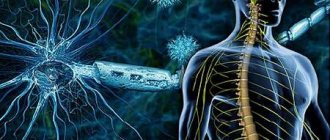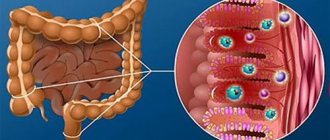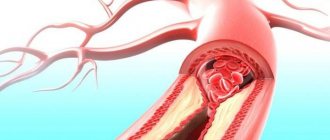02.09.2017
A deficiency of certain substances in the body leads to the development of pathological conditions. For example, a lack of vitamins B9 and B12 or the elements with which they are absorbed leads to the development of B12 folate deficiency anemia.
The general concept of anemia refers to a condition in which the level of hemoglobin and red blood cells in the blood decreases, leading to poor nutrition and oxygen supply to all organs.
To understand the scale of the problem, you need to know how important these vitamins are for the normal functioning of all human systems and organs.
Folic acid, also known as B9, is involved in many vital processes in the human body (in the regulation of fat and carbohydrate metabolism, in the process of hematopoiesis). Folic acid deficiency leads to a deterioration in general condition, as well as disruption of internal processes.
Symptoms of B9 deficiency are as follows:
- sleep problems, most often manifested in chronic insomnia;
- weakness, rapid fatigue from usual activities;
- depressive mood not associated with any life problems;
- pale skin;
- memory impairment;
- inflammation of tissues in the oral cavity.
You can replenish B9 reserves by eating oranges, parsley, black currants, and rosehip decoction. It is especially important to replenish vitamin reserves during pregnancy, when you need twice as much. Its deficiency can be determined in a blood test.
Cyanocobalamin, also known as B12, can accumulate in the liver, spleen, and kidneys. This vitamin is involved in the formation of blood cells and the nervous system, regulates the absorption of protein by the body. B12 deficiency leads to poor protein absorption, which leads to a lack of amino acids and nutrients.
You can replenish B12 reserves by eating seafood, veal, dairy products, and chicken egg yolks. A small percentage of the vitamin is found in spinach and seaweed. It’s hard for vegetarians, since plant foods contain virtually no important vitamin. They need to discuss separately with their doctor how to compensate for the vitamin deficiency in the diet.
Causes of B12 deficiency anemia
Modern medicine knows quite a lot of reasons that provoke the development of the pathological condition in question, but they all boil down to a lack of vitamin B12 in the human body. Therefore, the causes of B12 deficiency anemia should be considered in conjunction with the causes of the lack of the vitamin mentioned above.
The main reasons for the development of the disease in question are:
- Insufficient intake of vitamin B12 from food. The human body is not able to synthesize this vitamin on its own; it comes only from food. Plants do not contain vitamin B12; only meat, fish, and dairy products serve as its sources. As a rule, these products are included in the diet of every normal person, but in the case of chronic alcoholism or starvation, the development of B12 deficiency anemia is almost inevitable.
- Impaired absorption of vitamin B12 in the intestine. Factors leading to such impaired intestinal function are:
- autoimmune or atrophic gastritis;
stomach cancer;
- congenital deficiency of intrinsic factor Castle;
- inflammatory diseases of the small intestine (enteritis);
- intestinal tumors;
- parasitic infections.
- Increased use of vitamin B12 by the body. For normal functioning of the body, an adult requires 3-5 mcg of the vitamin in question per day. But under certain conditions, the body’s need for vitamin B12 increases significantly, and this can happen when:
- pregnancy - the processes of growth and cell division rapidly occur in the fetus, which requires more vitamin B12;
- hyperthyroidism - a large amount of thyroid hormones enters the bloodstream, metabolic processes intensify and the body requires more of the vitamin in question;
- malignant tumors - vitamin B12 is actively consumed by such neoplasms and nothing is supplied to the rest of the body.
- Hereditary diseases that are accompanied by impaired metabolism of vitamin B12. This factor can include a fairly large group of pathologies, but we will highlight only a few of them:
- Imerslund-Gresbeck syndrome;
- transcobalamin II deficiency;
- disruption of the use of vitamin B12 in cells.
Naturally, impaired intestinal absorption of vitamin B12 will also occur after removal of part of the stomach and small intestine for medical reasons.
It is worth noting that most often the cause of B12 deficiency anemia is insufficient intake of the vitamin in question in the body.
Please note: B12 deficiency anemia often develops in vegans who do not consume animal foods. The fact is that plant foods do not contain this vitamin, so vegans should consume foods artificially enriched with B12, as well as special vitamin complexes. For more information about the importance of vitamin B12 in a vegan diet and sources of this vitamin, read the article “Vitamin B12 in a vegan diet: why is it important?”.
What do the 2 types of megaloblastic anemia have in common and how do they differ?
B vitamins enter the human body with products of animal origin. In the stomach they bind to gastromucoprotein and are absorbed in the small intestine. For normal functioning of the body, the daily dosage of vitamin B12 should be 7 mcg.
The reserve of this vitamin in the liver is no more than 5 mg. The body's need for folic acid is about 100 mcg per day. Vitamin B9 supply up to 10 mg.
Disturbances in the synthesis of DNA molecules lead to the inability of these bone marrow cells to rapidly divide.
These cells include:
- The membranes of the mucous system,
- Digestive tract systems,
- bone marrow cells,
- Skin cells.
Cells of the hematopoietic system (hematopoietic) are cells that reproduce faster than others. Therefore, indicators (reduced levels of red blood cells and low hemoglobin coefficient) in the hematopoietic system characterize the first manifestations of megaloblastic anemia.
When anemia manifests itself, the following signs of hemolytic anemia are often observed:
- Pathology thrombocytopenia, decrease in the index of platelets in the blood,
- Disease neutropenia, decreased count of neutrophil-type leukocytes,
- Blood pathology agranulocytosis, decreased leukocyte index,
- The disease monocytosis is a decrease in monocyte molecules,
- Decreased reticulocyte synthesis.
The difference and relationship between folate deficiency B9 anemia and vitamin B deficiency B12:
- Vitamin B12 is involved in the synthesis of folic acid molecules. The acid is part of the thymidine molecule, which is a component of the DNA molecule. With the coordinated work of these components, and with their required quantity for the biochemical reaction, the normal formation of blood cells and cells for the normal functioning of the digestive tract occurs,
- The functional responsibilities of vitamin B12 are to help synthesize and break down fatty acids in the body. When there is a deficiency of cyanocobalamin molecules, a disruption in the coordinated reaction occurs, and methylmalonic acid is deposited, which has a detrimental effect on the atoms of neurons. There is also a decrease in the synthesis of myelin, which forms the sheath for nerve cell fibers.
Folic acid does not break down fatty acids and does not participate in the formation of sheaths for nerve fibers.
If there is a deficiency of vitamin B12, the doctor prescribes medications with folic acid, then it activates erythropoiesis, but only until this acid becomes abundant in the body.
An overdose of folic acid occurs:
- Disorder in the nervous system,
- Degenerative changes in the bone spinal cord,
- Combined sclerosis with loss of motor functions,
- Funicular type myelosis.
Symptoms of B12 Deficiency Anemia
The reserves of the vitamin in question in the human body are quite large, so there may not be clinical manifestations of B12 deficiency anemia for a long time. The disease develops very slowly and in the initial stages is characterized by weakness, increased fatigue and drowsiness - completely nonspecific symptoms.
The main clinical manifestations of B12 deficiency anemia include:
- Disturbance in the formation of blood cells. This is manifested by dizziness and frequent fainting, pallor and yellowness of the mucous membranes/skin, exercise intolerance, pain in the heart, rapid heartbeat, the appearance of “floaters” before the eyes and an enlarged spleen. In principle, if only one of the above manifestations appears, a person should seek qualified help, because it is not at all necessary that a complex of symptoms of impaired blood cell formation will be present at the same time.
- Damage to the digestive system. This symptom is the earliest sign of B 12 deficiency anemia, and it will manifest itself:
- indigestion;
- decreased appetite;
- pain and burning in the mouth;
- taste disturbance;
- pain in the epigastric region after eating;
- frequent infections in the oral cavity.
- Damage to the nervous system. Usually they appear only in the case of an advanced form of B12 deficiency anemia and are:
- sensory disturbances in the fingers and wrists;
- paresthesia – numbness, “tingling” in certain places of the body;
- decreased muscle strength;
- problems with urination and bowel movements.
The most dangerous manifestation of B12 deficiency anemia is mental disorders, as evidenced by psychosis, depression, hallucinations, convulsions, and insomnia.
Please note: all symptoms of the disease in question are nonspecific, that is, they may indicate the development of other diseases. Therefore, doctors always consider them only in conjunction with other diagnostic data.
Megaloblastic type of anemia
Pernicious (with B12 deficiency) anemia refers to the megaloblastic form of anemia, and is quite rarely combined with another megaloblastic folate deficiency anemia.
Megaloblastic anemia is a fairly rare form of pathology in which there is a deviation from the normal absorption of the digestive system of folic acid, vitamin B12 and the substance cyanocobalamin.
As a result, there is a lack of B vitamins in the body: B12 and B9.
Megaloblasts are modified red blood cells that are synthesized in DNA and RNA cells. Megaloblasts appear in bone marrow cells as a consequence of a deviation in the synthesis procedure. This is manifested in morphological changes in the composition of cells.
Diagnosis of B12 deficiency anemia
Merely the patient’s complaints about the symptoms described above are not a reason to diagnose the disease in question. The process of diagnosing B12 deficiency anemia is quite complex, since the following measures will need to be taken:
- examine blood by conducting general clinical and biochemical analysis in the laboratory;
- do a bone marrow puncture.
And a patient with suspected or already established B12 deficiency anemia must be thoroughly examined, since it will be necessary to find out the cause of the pathology.
How to treat
The basis of treatment is to compensate for the deficiency of vitamin B12. This may include adjusting your diet and taking medications. But self-medication is unacceptable, since not all vitamin complexes are able to cope with the task. B1 and folic acid are often added to the vitamin complex. If absorption is reduced, drugs are prescribed in the form of injections.
When correcting your diet, it is recommended to eat eggs, cheese, dairy products, kidneys and liver.
For problems with the gastrointestinal tract, treatment by a gastroenterologist and tests for intestinal parasites are additionally prescribed.
Treatment for B12 deficiency anemia
Treatment of the disease in question is carried out only comprehensively, because doctors are faced with the task of restoring the normal functioning of the hematopoietic, digestive and nervous systems as quickly as possible.
Drug treatment
The essence of this type of therapy is to administer vitamin B 12 externally. Indications for prescribing such treatment are a confirmed diagnosis of B12 deficiency anemia and a pronounced clinical picture of the disease in question.
Most often, vitamin B12 is administered intramuscularly, but it can also be taken orally in the form of tablets if the fact of insufficient intake of vitamin B12 from food is accurately established.
Treatment of the disease begins with intramuscular administration of 500-1000 mcg of vitamin B12 once a day . The duration of drug treatment is at least 6 weeks, then doctors transfer the patient to maintenance therapy - the dosage in this case will be 200-400 mcg of the drug 2-4 times a month. In some cases, such maintenance therapy is carried out throughout the patient's life.
Please note: during the period of drug treatment for B12 deficiency anemia, the patient must be monitored for the effectiveness of therapy - blood is drawn 2-3 times a week for laboratory testing. As a rule, after 1 month, complete normalization of peripheral blood parameters occurs, neurological manifestations weaken, and the functioning of the digestive system is restored. As soon as the patient is transferred to maintenance therapy, blood is drawn for analysis once a month.
Blood transfusion
This treatment method involves giving a blood transfusion to the patient, but more often red blood cells are used. Since this method is considered quite difficult and even dangerous in some sense, it is therefore used only if the patient’s life is in direct danger due to the development of β12 deficiency anemia . Unconditional indications for blood transfusion:
- severe anemia, when the patient's hemoglobin level is less than 70 g/l;
- anemic coma, manifested by loss of consciousness.
Since blood transfusion is prescribed only with a confirmed diagnosis, intramuscular administration of vitamin B12 is also prescribed simultaneously with this procedure. But blood or red blood cell transfusions are stopped as soon as the life-threatening condition of the patient is eliminated.
Nutrition correction
Very often, B12 deficiency anemia is treated with diet, but this is only possible with timely diagnosis of the disease. The patient's menu should include foods rich in vitamin B12 and important for the treatment of anemia:
plum juice;- green vegetables, herbs, salads and breakfast cereals;
- meat, cream and butter;
- beets, carrots, corn, tomatoes;
- offal – beef and chicken liver, heart;
- cod, carp, mackerel;
- rabbit meat.
It is important to eat nutritiously and variedly. Here is a sample daily menu for patients diagnosed with B12 deficiency anemia:
- 1 breakfast – fresh cabbage salad with apples and sour cream, omelette, oatmeal porridge with milk;
- 2nd breakfast – tea and 100 grams of cheese (maximum amount);
- lunch - borscht in meat broth with sour cream, fried chicken with boiled rice and compote;
- afternoon snack - rosehip decoction;
- dinner - meat zrazy with onion and egg, carrot puree, buckwheat casserole with cottage cheese, weak tea;
- at night - kefir.
Please note: a specialist should draw up a dietary menu for patients diagnosed with B12 deficiency anemia, since the general state of health, the presence of common pathologies and the individual sensitivity of the body to different foods should be taken into account.
Prevention
Prevention is mainly aimed at improving B12 intake through foods:
- Consumption of animal products containing large amounts of B12,
- Timely treatment of pathologies that can cause B12 deficiency and provoke anemia,
- After surgery on the digestive tract, take medications to maintain the level of this vitamin.
Foods rich in vitamin B12
Prognosis for B12 deficiency anemia
If the disease in question was diagnosed at an early stage of its development, treatment was immediately prescribed and is being carried out, and normalization of peripheral blood counts occurred within a month to a month and a half, then the prognosis will be extremely favorable. As soon as the basic therapy is carried out, the health condition is restored and the patient returns to the usual rhythm of life. But if there is:
- late start of treatment;
- symptoms of damage to the central nervous system;
- lack of effect from the treatment;
- hereditary form of B12 deficiency anemia,
then the forecasts will be unfavorable. Most likely, the patient will be forced to undergo treatment throughout his life; often a severe form of B12 deficiency anemia ends in coma and death.
B12 deficiency anemia is a condition that is not life-threatening, but very insidious. If a person pays attention to the earliest signs of the condition in question, then the doctor will be able to quickly establish the cause of the disease and carry out effective treatment.
Tsygankova Yana Aleksandrovna, medical observer, therapist of the highest qualification category
19, total, today
( 49 votes, average: 4.16 out of 5)
Increased neutrophils in the blood of a child: causes of deviations
Reduced red blood cells: causes of deviations
Related Posts
Why does the body need B12?
Cyanocobalamin ensures normal hematopoiesis, participates in protein metabolism, enzymatic reactions, is a catalyst for the conversion of amino acids, prevents fatty infiltration of the liver, and increases oxygen consumption at the cellular level.
With a lack of vitamin B12, symptoms in adults and children can manifest themselves in the form of decreased immunity. For example, AIDS patients always have low levels of B12, which is what provokes and accelerates the development of the disease.
If we take a deeper look at the regulation of hematopoietic function, it is necessary to highlight the participation of B12 in the processes of synthesis of purine and pyrimidine bases, as well as in the processing of nucleic acid. In addition, it is involved in the process of formation of red blood cells.
Another important function of cyanocobalamin is its effect on the nervous system. The substance is auxiliary in the formation of the myelin sheath of the nerve. In addition, it is involved in the conversion of carotene to retinol.
Diet food
You may be interested in: Non-surgical blepharoplasty: before and after photos, description of the method, reviews
People suffering from B12 deficiency anemia must follow dietary recommendations very strictly, as this promotes faster recovery. The diet must include dishes prepared from:
- whole grains;
- rabbit meat, lamb, beef;
- beans and peas;
- sea fish;
- chicken and beef liver.
A balanced diet is especially required during the period of intrauterine development of a child, since the formation of the fetus largely depends on the intake of vitamins in the pregnant woman’s body. You can prepare dishes in the usual way. You need to consume food 5 times a day. Be sure to drink enough water.
Carrying out diagnostics
You may be interested in: Intimate hygiene for women and men: rules and remedies
When diagnosing B12 deficiency anemia, the doctor initially collects an anamnesis. He must clarify how and when the first signs of the disease appeared and its characteristics. In addition, it is necessary to clarify whether a person has diseases that occur in a chronic stage, and also find out about the presence of possible congenital diseases.
After collecting anamnesis, the patient’s skin is examined, pressure index and heart pulse are measured. After an external examination, a blood test is prescribed. B12 deficiency anemia is characterized by a decrease in hemoglobin in the blood. In addition, additional instrumental studies are required, which are prescribed by the doctor.
With B12 deficiency anemia, a blood test shows a decrease in the number of red blood cell molecules, as well as decreased synthesis of reticulocytes. The hemoglobin level is reduced, and there is also a lack of platelets, which provokes hypoxia. When analyzing urine, the presence of proteins is noted and concomitant pathologies can be identified. Blood biochemistry is of particular importance. With anemia, you can identify indicators such as:
- increased cholesterol levels;
- increased glucose;
- presence of creatinine;
- presence of uric acid;
- the presence of potassium, calcium, sodium.
The hemogram shows the percentage of all types of leukocytes. Based on this, the leukocyte formula is established. The myelogram determines the production of red blood cell molecules, as well as the presence of megaloblasts in the blood. Instrumental techniques make it possible to identify deviations from normal indicators of the structure of internal organs, as well as possible violations of their functionality.
Possible complications
If emergency measures are not taken to treat anemia, serious complications can occur that pose a threat to human life. Among them it is necessary to note the following:
- coma;
- severe illness;
- destruction of cells of internal organs;
- myelosis.
A comatose state is characterized by the fact that the affected person does not respond to external stimuli. Coma occurs when the brain is hypoxic and can lead to the death of the patient.
A severe degree of the disease significantly worsens a person’s well-being and triggers irreversible consequences in the body. This degree occurs when the hemoglobin index is below 70 g/l. Funicular myelosis refers to damage to the cells of the spinal cord, as well as nerve endings. At the same time, the sensitivity of the limbs deteriorates, and unsteadiness of gait appears. As the pathology progresses, sensitivity completely disappears, and the person cannot move independently.
Over time, the cells of internal organs are completely destroyed, which provokes a disruption in their functioning. If the treatment process began very late, then complications simply cannot be prevented.











